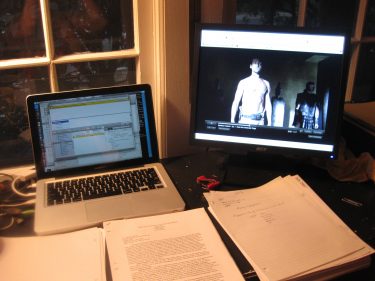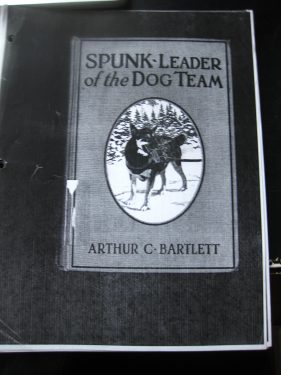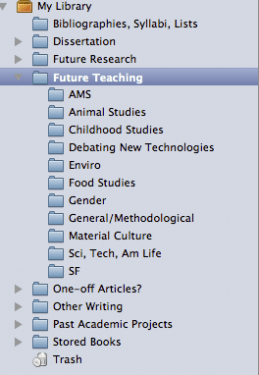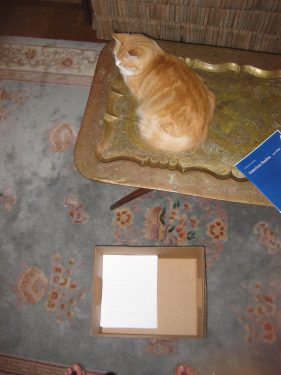This past week, I’ve been pursuing a highly enjoyable project—one that had such potential to become a swampy time-suck that I made myself wait to start until I had finished a draft of a chapter, and could think of it as a reward. Chapter drafted; time to geek out as follows.
Before I drank the digital Kool-Aid (committed to Zotero, bought a second, square-ish monitor for reading PDFs, and started taking pictures at archives instead of photocopying), I printed out a lot of stuff: reading materials for seminars, periodicals research for seminar papers, news articles that I thought I might someday use. What did I have to show for my pre-digital grad school life? A big trunk full of binders and notebooks, a file drawer stuffed with articles printed out from JStor, and four archival boxes filled with magazine and newspaper pieces I had clipped and marked “for future teaching.”

The Trunk, partway through excavation; unfortunately, a previous owner favored the use of mothballs, whose ghosts never fully die.
All of this stuff did me no good in its paper form. If I’m stuck for an idea or a reference—whether it be for my dissertation, for a friend or a Tweep, or for a syllabus in process—I never, ever go to the trunk, open it up, and start sifting through paper. It’s Zotero, every time. Digitizing would make that information visible to me, and it would also make any relocation in the next few post-doctoral years much easier. It was time to put everything in the same place.
I treated these faintly mothball-smelling pieces of paper the same way I would archival materials: I took digital pictures of the ones I thought I would want later on, and sorted those jpegs into folders inside a big folder on my desktop. I’ll turn all of these jpegs into PDFs (using Automator!), create Zotero records, and attach PDFs accordingly at a later date; this might take me a super-long time, but it’s a great zombie task: something I can do when I am absolutely unfit for any other effort. Like this paper-sifting itself, it’s also something I can do while watching TV. (I talked more about the jpeg-to-Zotero-record process in this post.)
Among all of the helpful-some-day book chapters, articles, and seminar handouts in these binders, I found two big treasure troves. The first was the archival material I collected from the University of Alaska/Anchorage for my masters’ thesis on celebrity sled dogs of the early 20th century. (Here’s a link [PDF] to a piece I wrote for The Crier on this same subject.) I don’t remember photocopying like a crazy person, but I guess I must have, because I found almost-complete copies of many of the key texts I looked at in the library and used in my thesis. I’d been thinking I might want to re-examine this material and see if it could be made into a book some day; the presence of all of this research right within my grasp makes the whole thing seem much more feasible.
The second trove is a sheaf of 1920s-1950s-era photocopied articles from Library Journal, Publisher’s Weekly, and other library periodicals, that one of my advisors gave me from her own research files. This group contains copies of lists of science books recommended for library adoption, as well as some other articles about science reading and national policy. These will be a big help when I write a chapter this summer about the publication of non-fiction science books for children in the first half of the 20th c—and an even bigger help if I realize my dream of making a database to represent trends in science publishing for kids in that period (more about that here—and if you have ideas, I’d love to hear them).
Happily for my future self, a large percentage of the papers hiding in my binders were printouts of content that I could re-find online and input into Zotero. (I can’t believe I used to print out JStor articles and read them on paper, but engage in this irrational behavior I certainly did. Perhaps a Future Me that’s converted completely to e-books will regard my present cluttered bookshelves as equally prehistoric.)
I was also able to find electronic versions of most of the pieces from Harper’s, the New Yorker, the Atlantic Monthly, and the NYRB that I clipped with future class assignments in mind. Because I’ll be going on the job market in the next couple of years, and I’m teaching my own class this coming year, I’m trying to expand my Zotero folder of ideas for teaching; this process took my collections a big leap ahead.
The idea of going through each and every page of hand-scrawled notes from seminars, lectures, and screenings was too time-sucky, even for me; besides, as I leafed through a few, I saw underlined titles of books I’d read in the intervening years and recorded in Zotero, which gave me a reassuring sense that I wouldn’t be missing anything if I spread my old notebooks out, took a picture, and prepared to throw them into the trash unread.

Pre-Z me loved to buy notebooks from Ex Libris Anonymous. And how about those pre-Google Calendar/smartphone day-planners?
A loose leaf fell out of one of them that saved all of their papery necks. These were my notes from the summer between my first and second year in grad school, when I went up to Alaska to visit my brother and to do that M.A. research. Turns out I wrote down some funny stuff. See bottom: “Strange Things To Eat: Fermented Blueberry Juice; Dead Man’s Thigh.” Or is it “Dead Mao’s Thigh”? Either way, the notebooks went back in the trunk. Maybe someday I’ll go through them all and digitize the pages that are important.
One folder in the file drawer contained only a few print-outs from microfiche, dating from the year that I went through the Saint Louis Post-Dispatch, looking for information about animals at the 1904 Louisiana Purchase Exposition, in my capacity as research assistant. I couldn’t (then or now) pass over gems like these without grabbing them and stuffing them into my coat pocket; in the digital age, I do this via Twitter or Facebook. So here goes:
SLPD article on features of the fair mentions a “Map Made of Pickles—Exhibited by a Pennsylvania firm. Represents the United States, 18×24 feet, made entirely of pickles, vegetables, fruits, etc. The state lines are accurately shown and the lakes and rivers are represented by vinegar. The large cities are indicated by spices.” N.D.
Headline: “Ghoul Stole His Sweetheart’s Body: Horrible Discovery in Dissecting Room Drove Him to Expose Grave Looters. He Did Not Know That His Fiancee Was Dead. Terror Froze His Blood When He Lighted Gas and Recognized Face of Corpse He Had Carried From Cemetery.” SLPD Feb 5, 1903
Headline #2: “Octopus in Woman’s Stomach. Two years’ Suffering Explained By Removal of Reptile [SIC] She Swallowed With Water.” (SLPD Jan 29, 1903)
There. That’s out of my system.
End result of project: Two boxes of scrap paper; twenty-one empty binders; four empty archival boxes; two three-foot stacks of recycling; 10.21 GB of jpegs to Zoterify; and an ever-more-stuffed Zotero. Now’s the time, I think, to take the plunge and invest in a second backup system; Time Machine + Carbonite might not be overkill, if I can ensure that the stash I’m building remains mine.








